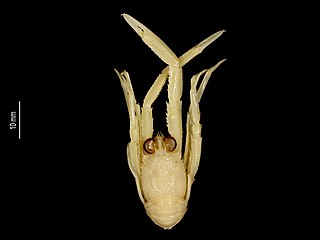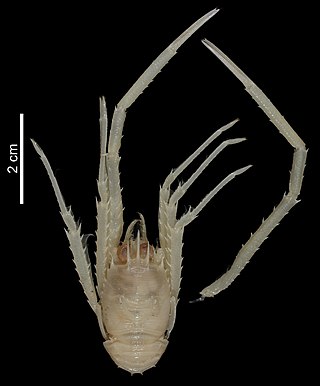
Squat lobsters are dorsoventrally flattened crustaceans with long tails held curled beneath the cephalothorax. They are found in the two superfamilies Galatheoidea and Chirostyloidea, which form part of the decapod infraorder Anomura, alongside groups including the hermit crabs and mole crabs. They are distributed worldwide in the oceans, and occur from near the surface to deep sea hydrothermal vents, with one species occupying caves above sea level. More than 900 species have been described, in around 60 genera. Some species form dense aggregations, either on the sea floor or in the water column, and a small number are commercially fished.

Galathea strigosa is a species of squat lobster in the family Galatheidae. It is found in the northeast Atlantic Ocean, from the Nordkapp to the Canary Islands, and in the Mediterranean Sea and Red Sea. It is edible, but not fished commercially. It is the largest squat lobster in the northeast Atlantic, reaching a length of 90 millimetres (3.5 in), or a carapace length of 53 mm (2.1 in), and is easily identified by the transverse blue stripes across the body.

Munida is the largest genus of squat lobsters in the family Munididae, with over 240 species.

Agononida is a genus of squat lobsters in the family Munididae. In 2022, recognizing that the genus as then defined was paraphyletic, it was divided into three lineages: Agononidasensu stricto and two new genera, Garymunida and Hexamunida. Agononida is distributed in the Indian and Pacific Oceans.
Anomoeomunida is a monotypic squat lobster genus in the family Munididae. The sole a species of is Anomoeomunida caribensis. It occurs in the western Atlantic.

Crosnierita is a genus of squat lobsters in the family Munididae, containing the following species:

Neonida grandis is a species of squat lobster in a monotypic genus in the family Munididae.

Paramunida is a genus of squat lobsters in the family Munididae, containing the following species:

Plesionida is a genus of squat lobsters in the family Munididae. As of 2017, it contains the following species:

Raymunida is a genus of squat lobsters in the family Munididae, containing the following 11 species:
Setanida cristata is a species of squat lobster in a monotypic genus in the family Munididae.

Shinkaia crosnieri is a species of squat lobster in a monotypic genus in the family Munidopsidae. S. crosnieri lives in deep-sea hydrothermal vent ecosystems, living off of the chemosynthetic activity of certain bacteria living on its setae.

Munididae is a family of squat lobsters, taxonomically separated from the family Galatheidae in 2010.

Garymunida isabelensis is a species of squat lobster in the family Munididae. The species name is from Isabel, one of the Solomon Islands. The males measure from 6.8 to 20.7 millimetres and the females from 5.7 to 31.5 millimetres. It is found off of the Solomon Islands, as the specific epithet implies. It is found at depths between about 240 and 350 metres.

Garymunida laurentae is a species of squat lobster in the family Munididae. The species name is dedicated to French carcinologist Michèle de Saint Laurent. The males measure from 5.8 to 28.6 millimetres and the females from 5.7 to 31.5 millimetres. It is found off of New Caledonia, Loyalty Islands, Chesterfield Islands, Vanuatu, and the Matthew and Hunter Islands, at depths between about 260 and 610 metres. It is also found in Tonga, at depths around about 570 metres (1,870 ft).
Garymunida procera is a species of squat lobster in the family Munididae, and was first described by Shane Ahyong and Gary Poore in 2004. The specific name is derived from procerus, a Latin word meaning "slender", which is in reference to its slender cheliped that distinguish it from the similar Agononida soelae. The females measure from 14.3 to 21.4 millimetres. It is found off of Eastern Australia and New Caledonia and near the Lord Howe Rise, where it is found at depths from 450 to 960 metres.
Garymunida soelae is a species of squat lobster in the family Munididae. The species is named for the research vessel Soela, which is the vessel on which the type specimen was collected. The males measure about 28.2 millimetres (1.11 in) and the females about 14.1 millimetres (0.56 in). It is found off of Indonesia, northwestern Australia, and New Caledonia, at depths between 450 and 620 metres. It is also found off of Fiji, where it resides between depths of about 680 and 725 metres.

Hexamunida sphecia is a species of squat lobster in the family Munididae. The species name is derived from the Greek sphex, meaning "wasp," which refers to the yellow and purple bands on its carapace. The males measure from 5.0 to 24.0 millimetres and the females from 6.0 to 17.1 millimetres. It is found off of New Caledonia, the Loyalty Islands, and the Chesterfield Islands, at depths between about 60 and 520 metres. It is also found off of both Fiji and Tonga, where it resides between depths of about 310 and 465 metres.
Garymunida squamosa is a species of squat lobster in the family Munididae. The males measure from 5.5 to 17.0 millimetres and the females from 5.1 to 16.4 millimetres. It is found off of Japan, Indonesia, the Admiralty Islands, northeastern Australia, New Caledonia, Loyalty Islands, and Wallis and Futuna, at depths between about 175 and 750 metres. It is also found off of Fiji and Tonga, where it resides between depths of about 350 and 590 metres.

Scolonida gracilis is a species of squat lobster in the family Munididae.














